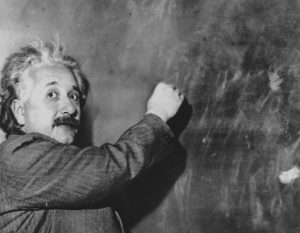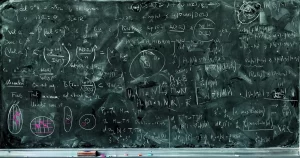Introdução
Todo ano, no dia 14 de março, cientistas, matemáticos e entusiastas ao redor do mundo celebram uma data muito especial. Afinal, não é só um dia qualquer — é o Pi Day, dedicado ao número mais famoso da matemática: Pi (π). Mas, curiosamente, essa data também marca o aniversário de ninguém menos que Einstein, um dos maiores gênios da física que já existiu. Coincidência? Talvez. Mas as conexões entre Pi e Einstein vão muito além do calendário.
Se por um lado Pi é um número infinito, sem padrões previsíveis, por outro, Einstein passou a vida inteira explorando os mistérios do universo, provando que o conhecimento também não tem limites. Pi aparece em equações fundamentais da física, incluindo algumas das mais importantes descobertas de Einstein, como a Teoria da Relatividade. Ou seja, de alguma forma, esses dois gigantes do mundo da ciência estão interligados.
Neste artigo, vamos explorar essa conexão fascinante entre um número matemático e um físico brilhante. Além disso, vamos entender como π vai muito além dos círculos e por que Einstein e sua busca pelo desconhecido continuam inspirando gerações. 🔢✨
📖 Aqui você encontra…
Nível:
B1
Objetivo:
Ampliar o vocabulário relacionado a matemática, física e ciência, além de compreender como Pi e Einstein se conectam na história e nos cálculos do universo.
Tópicos gramaticais abordados nesse texto:
- Present Simple: Usado para apresentar fatos científicos e verdades universais, como em “Pi is an infinite, non-repeating decimal.”
- Present Perfect: Para conectar o passado ao presente, como em “Einstein’s discoveries have transformed our understanding of space and time.”
- Passive Voice: Para enfatizar ações em vez do sujeito, como em “Pi is used in many areas of physics and engineering.”
- Relative Clauses: Para fornecer informações adicionais sem repetir ideias, como em “Einstein, who revolutionized physics, was born on March 14th.”
- Comparatives and Superlatives: Para contrastar ideias, como em “Pi is one of the most fascinating and mysterious numbers in mathematics.”
- Expressions of Time: Como “since ancient times,” “throughout history” e “every year on March 14th”, que situam eventos na linha do tempo.
A Perfect Equation of Genius and Infinity
Every year, March 14th (3/14) is a special day for science and mathematics. It’s Pi Day, a celebration of the most famous irrational number in history: π (Pi). But this date is even more special because it also marks the birthday of Albert Einstein, one of the greatest scientific minds of all time.
At first glance, a mathematical constant and a physics genius might not have much in common. But Einstein and Pi share more connections than you might think — from the fundamental equations of the universe to the endless pursuit of knowledge.
What Is Pi and Why Do We Celebrate It?
π ( 3.14159…) is a number that represents the ratio of a circle’s circumference to its diameter. No matter how big or small the circle is, this ratio remains the same. The fascinating part? Pi is an infinite, non-repeating decimal, meaning it goes on forever without ever forming a pattern.
Pi appears in geometry, physics, engineering, and even nature — from planetary orbits to the way rivers curve. Since its value starts with 3.14, March 14th (3/14) became the perfect date to celebrate its mathematical magic.
Einstein’s Birthday and His Link to Pi
Coincidentally (or maybe not?!), March 14th is also the birthday of Albert Einstein, who was born in 1879. Einstein revolutionized our understanding of space, time, and gravity with his Theory of Relativity.
But here’s where things get even more interesting:
- Einstein’s work relies on Pi – π appears in many of the fundamental equations of physics.
- Both Einstein and Pi represent infinity – Pi’s decimal expansion never ends, and Einstein believed that the pursuit of knowledge is limitless.
- Pi is key to understanding the universe – Einstein’s equations describe how gravity bends space, and Pi plays a role in those calculations.
It’s almost poetic that the man who reshaped our understanding of the cosmos was born on the very day we celebrate one of the most mysterious numbers in mathematics!
Pi in Physics: How It Appears in Einstein’s Work
If you thought Pi was only for circles, think again. It plays a major role in physics, including Einstein’s work. Here are some key examples:
- General Relativity: Einstein’s famous field equations contain π, which helps describe how space-time bends around massive objects like stars and black holes.
- The Shape of the Universe: The equations used to study planetary orbits, gravitational waves, and even the shape of the universe itself involve Pi.
- Energy and Motion: From wave functions in quantum physics to calculations in electromagnetism, π is deeply embedded in the fundamental forces of nature.
In short, Pi is more than just a quirky math fact — it’s part of the fabric of reality itself.
The Infinite Nature of Knowledge and Pi
Einstein once said, “The important thing is not to stop questioning. Curiosity has its own reason for existing.” This idea mirrors the infinite nature of Pi—just as we can never fully reach the end of Pi’s decimal expansion, we will never reach the limits of knowledge.
Mathematics, physics, and the universe itself are vast, and both Pi and Einstein remind us that there is always more to discover.
A Day to Celebrate Math and Science
March 14th is more than just a day for math lovers. It’s a celebration of discovery, curiosity, and the never-ending quest for knowledge—the same spirit that guided Einstein and the same mathematical mystery found in π.
So, how will you celebrate Pi Day this year? Maybe by memorizing more digits of it(can you beat 3.14159?), watching an Einstein documentary, or simply taking a moment to appreciate the beauty of science.
And now?
Want to Expand Your Knowledge?
At Apollo Academy, we believe that learning never ends — just like Pi! Whether you want to improve your English, expand your scientific vocabulary, or challenge yourself with new ideas, we’ve got the right course for you.
📞 Contact us today and start your journey of limitless learning!






